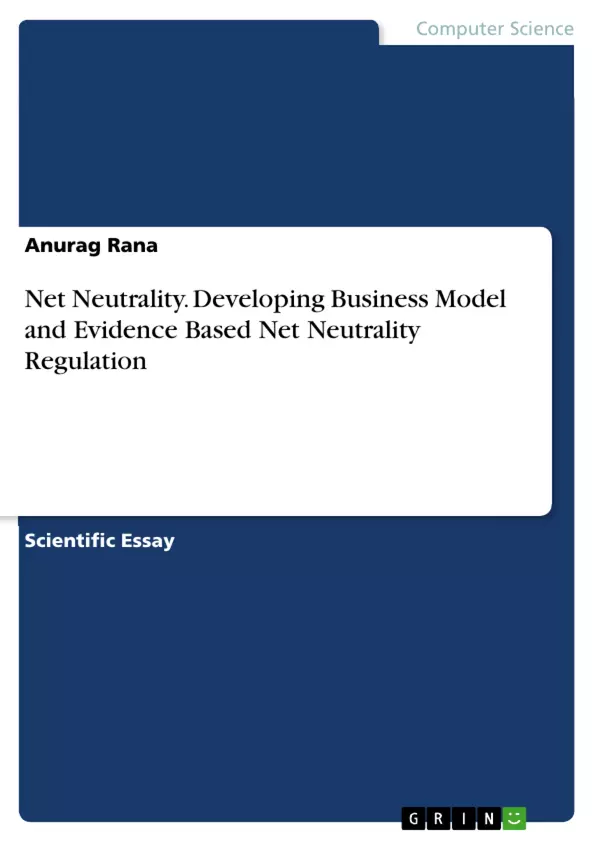Over the past ten years, the debate over "network neutrality" has remained one of the central debates in Internet policy. Governments all over the world have been investigating whether legislative or regulatory action is needed to limit the ability of providers of Internet access services to interfere with the applications, content and services on their networks. Net neutrality comprises two separate non-discrimination commitments. Backward-looking ‘net neutrality lite’ claims that Internet users should not be disadvantaged due to opaque and invidious practices by their current Internet Service Provider (ISP). Forward-looking ‘positive net neutrality’ is a principle whereby higher Quality of Service (QoS) for higher prices should be offered on fair, reasonable and non-discriminatory (FRAND) terms to all-comers. Neither extreme in the debate is an optimum solution. There is too much at stake to expect government to supplant the market in providing higher-speed connections, or for the market to continue to deliver without basic policy and regulatory backstops to ensure continued openness. Permitting content discrimination on the Internet will permit much more granular knowledge of what an ISP’s customers are doing on the Internet. A co-regulatory regime will ensure oversight and remove the most obvious abuses by fixed and mobile ISPs. Beyond rules that forbid network providers from blocking applications, content and services, non-discrimination rules are a key component of any network neutrality regime.
This analytical study provides background on the debate over network neutrality, including the implications for business models going forward that have been attempted and that are currently in play. This article explains for a global policy audience what the regulatory and governance problems and potential solutions are for the issue referred to as ‘network neutrality’, unpacking its ‘lite’ and ‘heavy’ elements. Eschewing technical, economic or legalistic explanations previously tackled elsewhere, it explains that increasing Internet Service Provider (ISP) control over content risks not just differentiated pricing and speed on the Internet. It explains that a co-regulatory regime may ensure regulatory oversight and remove obvious abuses by fixed and mobile ISPs, without preventing innovation, while guarding against government abuse of the censorship opportunities provided by new technologies.
Inhaltsverzeichnis (Table of Contents)
- I INTRODUCTION
- II DEVELOPING BUSINESS MODELS
- An Emergence of the two-lane model
- Public Internet lane offers more openness
- Quality guarantees in the managed services lane
Zielsetzung und Themenschwerpunkte (Objectives and Key Themes)
This analytical study examines the complex issue of network neutrality, providing a comprehensive overview of the ongoing debate, including its implications for evolving business models. The study analyzes the various definitions of network neutrality and explores the potential societal welfare concerns associated with departures from neutrality.
- The development and evolution of network neutrality in the context of changing Internet business models.
- The distinction between the 'public Internet lane' and the 'managed services lane' and their implications for openness and quality guarantees.
- The role of access and interconnection in ensuring openness on the public Internet.
- The technical and economic challenges associated with implementing Quality of Service (QoS) guarantees on the Internet.
- The potential impact of network neutrality on competition, innovation, freedom of expression, consumer awareness, and privacy.
Zusammenfassung der Kapitel (Chapter Summaries)
- I INTRODUCTION: This chapter introduces the concept of network neutrality, outlining its various definitions and highlighting the key societal welfare concerns arising from departures from neutrality.
- II DEVELOPING BUSINESS MODELS: This chapter explores the emergence of the "two-lane model" in Internet service provision, differentiating between the public Internet lane and the managed services lane. It analyzes the advantages and disadvantages of each lane in terms of openness and quality guarantees. This chapter further examines the technical and economic challenges associated with implementing QoS guarantees on the Internet.
Schlüsselwörter (Keywords)
The study focuses on the core concepts of net neutrality, internet service providers, non-discrimination, quality of service, and the evolving dynamics between the public Internet and managed services. These concepts are essential in understanding the ongoing debate and its implications for the future of the internet.
- Quote paper
- Anurag Rana (Author), 2014, Net Neutrality. Developing Business Model and Evidence Based Net Neutrality Regulation, Munich, GRIN Verlag, https://www.grin.com/document/274066



